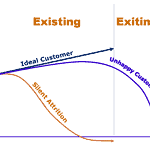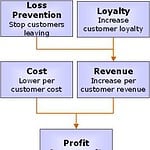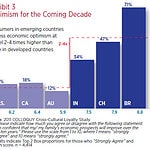Customer retention is an important driver of overall business value. It’s quite simple: the fewer customers you lose the faster you grow.
For B2C, i.e. retail businesses, the customer retention road is relatively well worn. Customer save teams, predictive analytics, save offers are all part of the standard B2C customer retention arsenal.
But what about B2B customer retention strategies?
That’s a little more difficult because the relationship is more complex. More people are involved, switching costs are typically much higher and the risk of getting it wrong is also much higher … for both parties
In this post I’ll review recent research that identified how to detect a B2B customer that is getting ready to defect 3-6 months ahead of time and provide practical strategies to prevent that churn.
The Attitudes of B2B Stayers and Defectors
This paper: Customer attitudes of stayers and defectors in B2B services: Are they really different? analysed the actual B2B customer retention performance of a fortune 100 company to uncover how stayers and defectors are different.
The business delivers annual maintenance contracts in a B2B industry. Contracts are valued at between USD 10,000 and USD 100,000 per annum.
Research design was simple, and powerful:
- Survey customers on their perceptions;
- Study what they actually do, stayed (n=948) or defected (r=75),
- Analyse the data to uncover how the two groups are different.
The survey collected data on a range of business attributes: price, service performance, account representative performance, call centre performance, customer satisfaction and Behaviour Intentions.
NB: Behavioural Intentions consisted of combing “willingness to recommend”, a.k.a. Net Promoter Score, and Likelihood to Renew.
This research design is relatively rigorous because it compares what actually happened, not just what customers say they might do.
How to Predict B2B Customer Churn 6 Months Out
The critical finding to come from this research is that:
Behavioural intentions are a solid predictor of impending customer defection in B2B industries and provide 3-6 months warning of actual defection.
Both Customer Satisfaction and “Behavioural Intentions” were higher in the stayer group than the defector group.
In the case of Behavioural Intentions, that difference was significantly larger, and therefore easier to spot.
However there are other relevant insights from this paper – the most important of which is:
Stayers and Defectors were more similar than they were different. Neither Price nor Service level perceptions were significantly different.
This is a surprise.
This means that monitoring perceptions of service levels, account management performance and even pricing does not provide effective predictive information and could easily lead to a false sense of security.
Notably, while price perceptions were the same, Defectors appeared to be more price sensitive.
In my opinion this price sensitivity is an outcome of declining overall satisfaction with the vendor, not the driver of dissatisfaction.
I’m not as happy with you as a vendor. Your perceived value has declined and now I’m less happy about the price I’m paying.
Only the monitoring of Behavioural Intentions, e.g. NPS. was predictive of churn.
Practical B2B Retention Strategies
Here is a practical way to use this information to improve your B2B customer retention.
Step 1: Perform Regular Customer Surveys with a Behavioral Intention Question (NPS)
A best practice Net Promoter Score survey is an example of a behavioural intention survey.

You need to run the data collection process on a regular basis: 3 monthly at the very least in order to capture changes in customer perceptions AND provide you the lead time you need to recover the citation.
If you only survey once a year you are very likely to be too late to intervene before the customer has put in place the steps to leave.
An automated, integrated NPS management system is the easiest approach.
Step 2: Look for Declining Scores in High Value Accounts
Step 2 is to track your individual and account level scores on a rolling monthly basis. Wherever you see scores declining you can be sure the risk of losing them as a client is increasing and you need to act.
For added effectiveness, combine your NPS data with account revenue or profitability data to help you prioritize action. Triaging in this way helps you focus on the important clients.
Step 3: Intervene Heavily 3-6 months out From Contract Renewal
It’s no good waiting until the last week of the contract. You must act much sooner if you want to save a B2B customer.
Decision making in a B2B context is typically much more involved and the lead time on change is longer than in a B2C context. It’s not like changing electricity suppliers or grocery stores.
If customers are planning to leave, they will have made the decision long before the renewal so they have time to ready an alternative supplier to take over before they notify you of cancellation.
The good news is that declining scores can give you that 3-6 month warning of impending client loss, but you need to act quickly to take advantage of that warning.
The intervention will depend on your business but will likely include:
- Re-engaging your account management and senior executives with your client’s staff to understand what is causing reduced satisfaction and start planning resolutions.
- Using the customer feedback data you have collected in the review process to demonstrate you’re listening and changing.
- Creating action plans to resolve issues
B2B Customer Retention FAQs
How do you calculate customer retention rate?
Customer retention rate is the number of customers lost in the period divided by the total number of customers at the start of the period. It is usually expressed as a percentage: “Last quarter we had a customer retention rate of 93%.
This can be calculated on a customer number or revenue basis and the period can be any applicable to the business but year, quarter and month are the most common.
How do you calculate Customer Lifetime Value?
In simple terms, customer lifetime value is the sum total of value generation from a client between acquisition and loss. It’s calculation should include revenue, direct costs, acquisition costs, operational costs and average customer lifetime. It should also be adjusted for cost of capital for the organisation.
Download our free: Customer Lifetime Value Calculator
Get the Business Leader's Guide to Net Promoter Score Download Here









